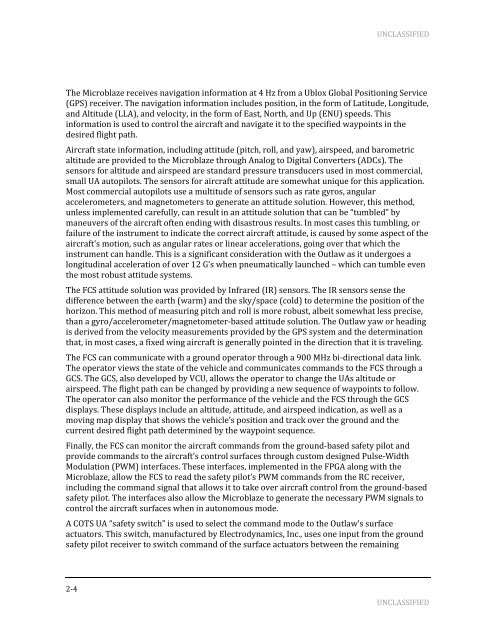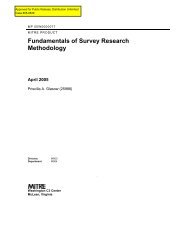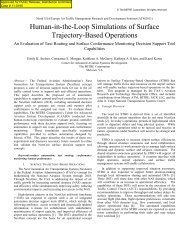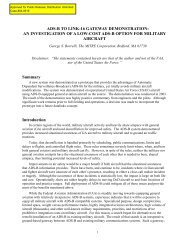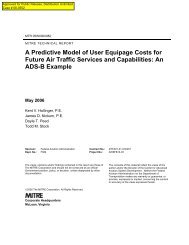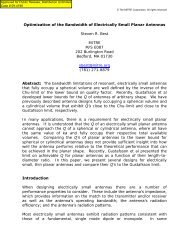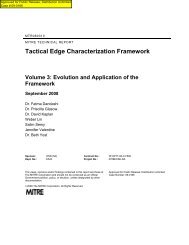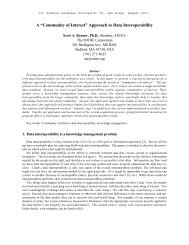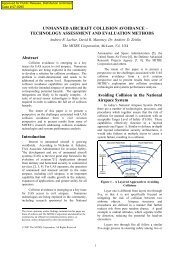Unmanned Aircraft System (UAS) Exercise to Assess ... - Mitre
Unmanned Aircraft System (UAS) Exercise to Assess ... - Mitre
Unmanned Aircraft System (UAS) Exercise to Assess ... - Mitre
You also want an ePaper? Increase the reach of your titles
YUMPU automatically turns print PDFs into web optimized ePapers that Google loves.
2-4<br />
UNCLASSIFIED<br />
The Microblaze receives navigation information at 4 Hz from a Ublox Global Positioning Service<br />
(GPS) receiver. The navigation information includes position, in the form of Latitude, Longitude,<br />
and Altitude (LLA), and velocity, in the form of East, North, and Up (ENU) speeds. This<br />
information is used <strong>to</strong> control the aircraft and navigate it <strong>to</strong> the specified waypoints in the<br />
desired flight path.<br />
<strong>Aircraft</strong> state information, including attitude (pitch, roll, and yaw), airspeed, and barometric<br />
altitude are provided <strong>to</strong> the Microblaze through Analog <strong>to</strong> Digital Converters (ADCs). The<br />
sensors for altitude and airspeed are standard pressure transducers used in most commercial,<br />
small UA au<strong>to</strong>pilots. The sensors for aircraft attitude are somewhat unique for this application.<br />
Most commercial au<strong>to</strong>pilots use a multitude of sensors such as rate gyros, angular<br />
accelerometers, and magne<strong>to</strong>meters <strong>to</strong> generate an attitude solution. However, this method,<br />
unless implemented carefully, can result in an attitude solution that can be “tumbled” by<br />
maneuvers of the aircraft often ending with disastrous results. In most cases this tumbling, or<br />
failure of the instrument <strong>to</strong> indicate the correct aircraft attitude, is caused by some aspect of the<br />
aircraft's motion, such as angular rates or linear accelerations, going over that which the<br />
instrument can handle. This is a significant consideration with the Outlaw as it undergoes a<br />
longitudinal acceleration of over 12 G’s when pneumatically launched – which can tumble even<br />
the most robust attitude systems.<br />
The FCS attitude solution was provided by Infrared (IR) sensors. The IR sensors sense the<br />
difference between the earth (warm) and the sky/space (cold) <strong>to</strong> determine the position of the<br />
horizon. This method of measuring pitch and roll is more robust, albeit somewhat less precise,<br />
than a gyro/accelerometer/magne<strong>to</strong>meter-based attitude solution. The Outlaw yaw or heading<br />
is derived from the velocity measurements provided by the GPS system and the determination<br />
that, in most cases, a fixed wing aircraft is generally pointed in the direction that it is traveling.<br />
The FCS can communicate with a ground opera<strong>to</strong>r through a 900 MHz bi-directional data link.<br />
The opera<strong>to</strong>r views the state of the vehicle and communicates commands <strong>to</strong> the FCS through a<br />
GCS. The GCS, also developed by VCU, allows the opera<strong>to</strong>r <strong>to</strong> change the UAs altitude or<br />
airspeed. The flight path can be changed by providing a new sequence of waypoints <strong>to</strong> follow.<br />
The opera<strong>to</strong>r can also moni<strong>to</strong>r the performance of the vehicle and the FCS through the GCS<br />
displays. These displays include an altitude, attitude, and airspeed indication, as well as a<br />
moving map display that shows the vehicle’s position and track over the ground and the<br />
current desired flight path determined by the waypoint sequence.<br />
Finally, the FCS can moni<strong>to</strong>r the aircraft commands from the ground-based safety pilot and<br />
provide commands <strong>to</strong> the aircraft’s control surfaces through cus<strong>to</strong>m designed Pulse-Width<br />
Modulation (PWM) interfaces. These interfaces, implemented in the FPGA along with the<br />
Microblaze, allow the FCS <strong>to</strong> read the safety pilot’s PWM commands from the RC receiver,<br />
including the command signal that allows it <strong>to</strong> take over aircraft control from the ground-based<br />
safety pilot. The interfaces also allow the Microblaze <strong>to</strong> generate the necessary PWM signals <strong>to</strong><br />
control the aircraft surfaces when in au<strong>to</strong>nomous mode.<br />
A COTS UA “safety switch” is used <strong>to</strong> select the command mode <strong>to</strong> the Outlaw’s surface<br />
actua<strong>to</strong>rs. This switch, manufactured by Electrodynamics, Inc., uses one input from the ground<br />
safety pilot receiver <strong>to</strong> switch command of the surface actua<strong>to</strong>rs between the remaining<br />
UNCLASSIFIED


